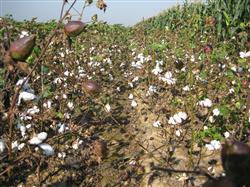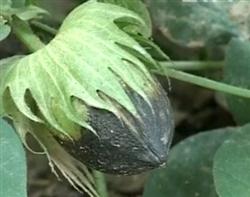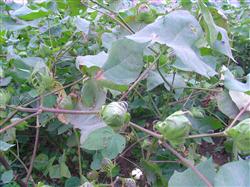How to prevent premature senescence in the later stage of cotton?

How to prevent premature senescence in the later stage of cotton? Please introduce the method the internal reason for the early senescence of cotton in the later stage is that after the cotton growth entered August, there was a fierce competition for nutrients among roots, stems, leaves and bolls, resulting in an imbalance between nutrient supply and demand. The external cause is the lack of water and fertilizer in the later stage of cotton field, such as phosphorus deficiency or potassium deficiency. There are also some cotton fields because there are too many spraying times in the later stage, or the concentration of pesticides is too high, which causes serious damage to cotton leaves. It should be pointed out that the fundamental measure to prevent premature senescence of cotton is to strengthen the basic construction of cotton fields, that is, to carry out deep ploughing and fine harrowing of cotton fields, increase the application of organic fertilizer and maintain the balance of various elements in the soil. When cotton enters the late growth stage, only the following remedial measures can be taken: 1. Fertilizer and water management: it is necessary to re-apply flower and boll fertilizer according to seedling condition, climate and soil condition. if flower and boll fertilizer is insufficient, cover top fertilizer should be applied again. After entering the middle of August, if the maximum water holding capacity in the field is less than 60%, and when it is less than 55% in the first ten days of September, it is necessary to water in time and promote fertilizer with water to ensure that the fertilizer effect is brought into full play in time. If the premature senescence of cotton is caused by the lack of potassium in the soil, the application of potassium sulfate or potassium chloride should be increased by 5kg of potassium sulfate or potassium chloride at the seedling stage while applying base fertilizer. When applying fertilizer, we must plough more than 20 centimeters, apply fertilizer to the bottom of the plow, apply fertilizer deeply, promote the root system, reduce fertilizer loss, and improve fertilizer use efficiency. Water should be watered in case of drought during flowering and boll setting period, ditch boxes should be carefully cleaned to prevent further water stains, and waterlogging should be drained in time when waterlogging occurs. two。 Reasonable chemical control: in order to prevent premature senescence caused by early onset of plants, chemical control time and dosage of zhuangsu should be comprehensively considered in combination with climate, soil fertility and appearance. Generally, a small amount of regulators such as zhuangsu are sprayed many times at 8-leaf stage, bud stage, early flowering stage, full flowering stage and after topping, in order to achieve the purpose of reasonable regulation. 3. Extra-root topdressing: after August, the cotton fields deficient in phosphorus and potassium can be sprayed with 300 × 500 times of potassium dihydrogen phosphate every 10-15 days, 60,80kg per 667 square meters (1 mu). For nitrogen deficient cotton field, 200 times urea solution can be sprayed. Topdressing outside the root can be sprayed all day in cloudy days and in sunny days in the evening to avoid burns to leaves. 4. Break the hardening: for the unsealed cotton fields, especially in the hilly areas, the soil should be loosened in time to break the hardening after the rain. Do not loosen the soil too deep, so as not to damage the root system and destroy the soil. It can also be sprayed with soil conditioner "no deep tillage". Spraying "no-deep tillage" can break the consolidation, loosen the soil, improve the soil structure, give full play to the fertilizer effect, promote the normal growth of the root system, and improve the root absorption capacity. The method of spraying "no deep tillage": every 667 square meters, 200 ml of medicine is mixed with 50 kg of water and sprayed evenly on the soil cultivation line. 5. Topping and pruning: first of all, fine pruning in time, removal of ineffective buds, buds after the Beginning of Autumn or flowers after White Dew should be removed to reduce consumption. Secondly, there should be fewer fruit nodes for the lower fruit branches, one for the first and second fruit branches, and two for the third and fourth fruit branches. This method can save organic nutrients and prevent cotton from premature senescence in the later stage. 6. Protection against insects and leaves: the functional period of normal leaves is generally about 8 weeks, but due to the influence of pests such as cotton bollworm, blind Toona sinensis, red spiders and diseases such as Fusarium wilt, Verticillium wilt and red leaf stem blight, the leaves are damaged or shedding, reducing the function of leaves and speeding up premature senescence. Therefore, it is necessary to control insect pests, reduce diseases and prolong leaf function. In the early stage of the onset of Verticillium wilt, the root can be irrigated with 1000 times of carbendazim (0.5kg / plant), or sprayed with fulvic acid and Fangjiele. Click to get more cotton planting technology click to get more food crop planting technology
- Prev

How to control cotton rotten bolls (peaches)?
How to control cotton rotten bolls (peaches)? Cotton boll rot occurs mostly in late August to early September, during which time if rainy and wet, hidden cotton fields, poor ventilation and light transmission, a variety of pathogens will breed rapidly. Common cotton boll rot disease mainly anthracnose, black fruit disease, blight, red rot, pink...
- Next

How to fertilize cotton in the later stage?
How to fertilize cotton in the later stage? Please introduce the method around mid-late September is the late growth stage of cotton, during this period, the nutrient absorption capacity of cotton root system decreases obviously, but if nitrogen, phosphorus, potassium, zinc, boron and other fertilizers are sprayed on cotton leaves, it can prevent premature senescence, promote precocious maturity, prevent disease, prevent boll falling, and knot.
Related
- The first cup of black tea in spring, the flavor and history of tea gardens in Kenya, Africa
- The computer can not only choose potatoes, but also grow tea rice. AI will grow winter oolong tea champion.
- It is not only the inflated tea bitten by insects, but also engraved with the four seasons tea in Beipu.
- The Oriental Beauty Tea Festival in Zhuxian County takes the stage at the weekend to experience the plus-size feast of oil tea.
- & quot; Oriental Beauty Tea & Exploration of Emei in Hsinchu, the hometown of quot;
- The new variety of strawberry "Tainong 1" dessert is the first choice with mellow aroma. Crimson gorgeous
- History of Tea in Taiwan: from Wild Inner Mountain to Export Tea Garden
- Two types of Taiwan Oriental Beauty Black Tea won the British three-Star Award for Childhood Tea Xiang Zhang Jiaqi changed from pilot to champion tea maker.
- Banana species and varieties: the planting history of Taiwan Xianren banana and dwarf banana is long, is banana disease resistant?
- Coffee planting Technology: Qianjie Coffee from Seedling to harvesting

